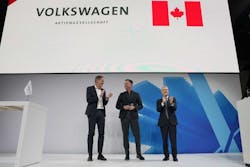Volkswagen chooses Ontario for PowerCo Battery Cell Manufacturing plant
Germany’s Volkswagen Group will locate its first overseas battery cell manufacturing gigafactory in Canada.
The automaker, which has pivoted to focus on electric vehicles in the future, will build its first North American battery cell factory in St. Thomas, Ontario. Volkwagen’s battery group, PowerCo SE, will lead the project with start of production expected by 2027.
The move is the latest battery manufacturer to announce plans for North American manufacturing as the U.S. and Canada work to tighten supply chains in the wake of both the pandemic struggles and political tensions globally.
“Our gigafactory in Canada sends a strong message: PowerCo is on track to become a global battery player,” Thomas Schmall, board member for technology at Volkswagen AG and Chairman of the Supervisory Board of PowerCo SE, said in a statement. “With the expansion to North America, we will enter a key market for e-mobility and battery cell production, driving forward our global battery strategy at full speed.
“Canada and Ontario are perfect partners for scaling up our battery business and green economy jobs, as we share the same values of sustainability, responsibility and cooperation,” Schmall added.
St. Thomas will be Volkswagen AG’s third group-owned cell manufacturing plant worldwide, after projects announced for Salzgitter, Germany and Valencia, Spain.The Canadian deal builds off of a larger plan that Volkswagen, PowerCo and Prime Minister Justin Trudeau discussed last year.
Volkswagen plans to introduce more than 25 new battery electric vehicle models through 2030, including many versions in North America and the United States. The automaker has an assembly plant for the all-electric ID.4 compact SUV in Chattanooga Tennessee, and plans to upgrade plants Puebla and Silao, Mexico.
“Our North American strategy is a key priority in our 10-point-plan that we’ve laid out last year,” Volkswagen Group CEO Oliver Blume said in the release. With the decisions for cell production in Canada and a Scout site in South Carolina we’re fast-forwarding the execution of our North American strategy.”
Earlier this year, South Carolina state leaders voted for a $1.3 billion incentives package to incentivize Volkswagen to build a Scout assembly plant in that state.
Oklahoma also was in the running for the battery cell production plant now planned in Canada. The state offered close to $700 million in incentives.
Other companies which have announced battery component manufacturing plants in the U.S. or elsewhere in North America include Panasonic Energy, Microvast, Honda-LG Energy Solutions, AESC, FREYR Battery, Canoo, Molex and Fluence Energy.
-- -- --
(Rod Walton, senior editor for EnergyTech, is a 15-year veteran of covering the energy industry both as a newspaper and trade journalist. He can be reached at [email protected]).
Follow us on Twitter @EnergyTechNews_ and @rodwaltonelp and on LinkedIn
About the Author
Rod Walton, EnergyTech Managing Editor
Managing Editor
For EnergyTech editorial inquiries, please contact Managing Editor Rod Walton at [email protected].
Rod Walton has spent 17 years covering the energy industry as a newspaper and trade journalist. He formerly was energy writer and business editor at the Tulsa World. Later, he spent six years covering the electricity power sector for Pennwell and Clarion Events. He joined Endeavor and EnergyTech in November 2021.
Walton earned his Bachelors degree in journalism from the University of Oklahoma. His career stops include the Moore American, Bartlesville Examiner-Enterprise, Wagoner Tribune and Tulsa World.
EnergyTech is focused on the mission critical and large-scale energy users and their sustainability and resiliency goals. These include the commercial and industrial sectors, as well as the military, universities, data centers and microgrids. The C&I sectors together account for close to 30 percent of greenhouse gas emissions in the U.S.
He was named Managing Editor for Microgrid Knowledge and EnergyTech starting July 1, 2023
Many large-scale energy users such as Fortune 500 companies, and mission-critical users such as military bases, universities, healthcare facilities, public safety and data centers, shifting their energy priorities to reach net-zero carbon goals within the coming decades. These include plans for renewable energy power purchase agreements, but also on-site resiliency projects such as microgrids, combined heat and power, rooftop solar, energy storage, digitalization and building efficiency upgrades.

